All About Salt (yes, type matters!)
When it comes to cooking, salt matters. Learn about several types of salt you can cook with and their differences, so you can unlock the flavor of foods!
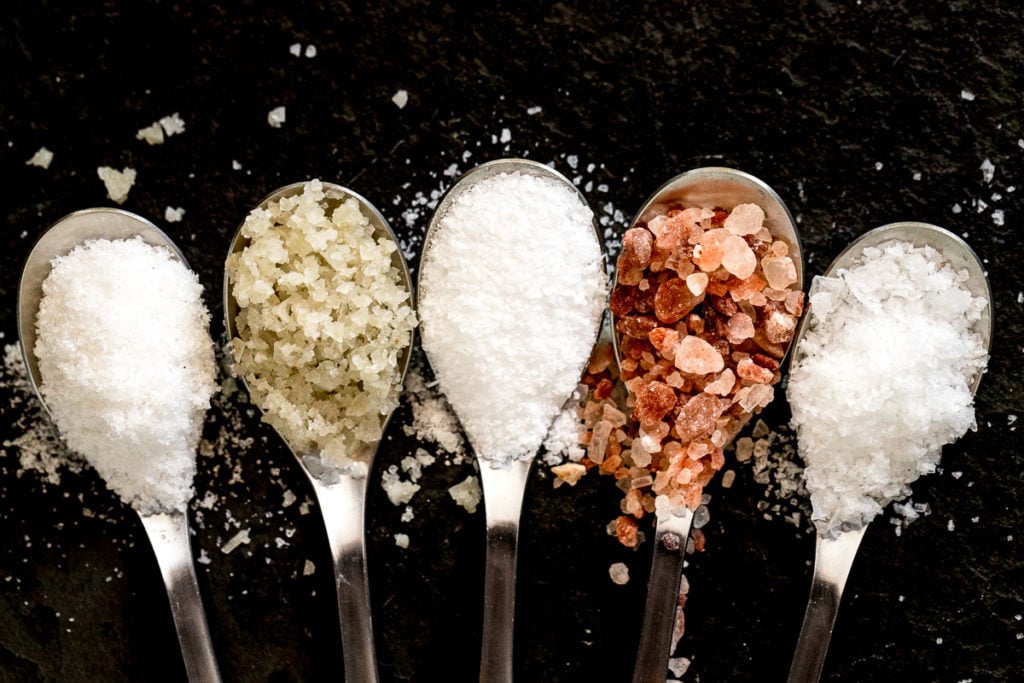
All salt is not created equal, and size does in fact, matter.
Or, to be technical about it, density matters. While different salt types are the same foundationally, and chemically, and generally have the same basic nutritional value (more on minerals later), there are key differences when it comes to cooking.
And those key differences, make all the difference. The salt you use, and how you use it, does matter, and it’s important to learn the differences between salts so that you are able to use whatever salt you have on hand to make the most magic in the kitchen.
Table of Contents
- What is Salt & Why is it Important?
- Kosher Salt
- Sea Salt
- Table Salt
- Other Kinds of Salt
- Why Density Matters
- How to Properly Salt Food
- Let’s Practice!
What is Salt & Why is it Important?
At its most basic explanation, salt is a mineral. It is essential to keep our bodies functioning properly, but it’s also the key component in bringing out flavor in foods. It greatly influences how we perceive the flavor of foods.
We have five basic tastes, salt is one of them, in addition to sweet, sour, bitter, and umami – or savoriness (I love talking about umami in vegetarian cooking!).
One of my favorite books on cooking is Salt, Fat, Acid, Heat by Samin Nosrat. It’s revolutionary in describing how these 4 elements impact our cooking and taste, and how critical they are to making food shine. Be sure to grab a copy to dive deeper into exactly how salt works for specific food types, because how and when you use salt really matters.
Nosrat describes how salt impacts both the taste and flavor of food; flavor being the crossing between taste, aroma, and sensory elements like appearance and temperature. Salt essentially unlocks the flavor of foods, which is why you often see ‘salt to taste‘, because you’ve got to taste the dish to know when salt has fully brought out the flavors.
Salting foods is not just a one-and-done kind of action, either. It’s a process that unfolds throughout cooking. So let’s dive into the different kinds of salts, and when and how to use them (especially here at FITK!).
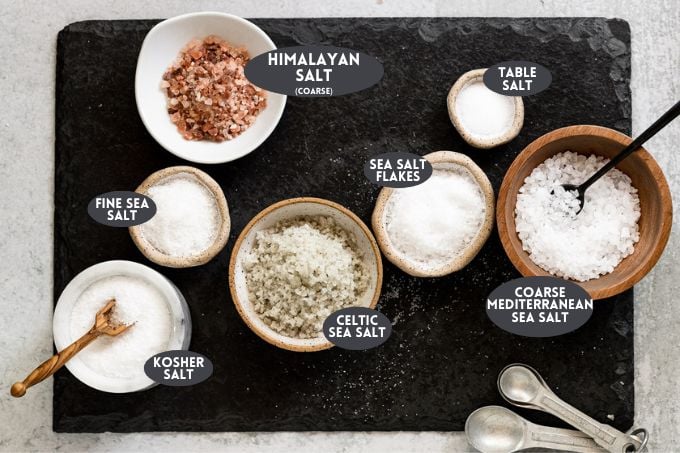
Kosher Salt
Kosher Salt is a very popular cooking salt. It is coarser than the common table salt, with crystals that are asymmetrical. It was originally used to kosher meat, however, you’ll find it in home and professional kitchens these days for generally flavoring foods.
The bigger crystals are easier to use to evenly salt foods because their size allows you to easily pinch and sprinkle them. It’s excellent for seasoning meats or fish filets. Kosher salt is slower to dissolve compared to sea salt, so it’s perfect for layering flavor into recipes like soups where it will have a chance to incorporate throughout the cooking process.
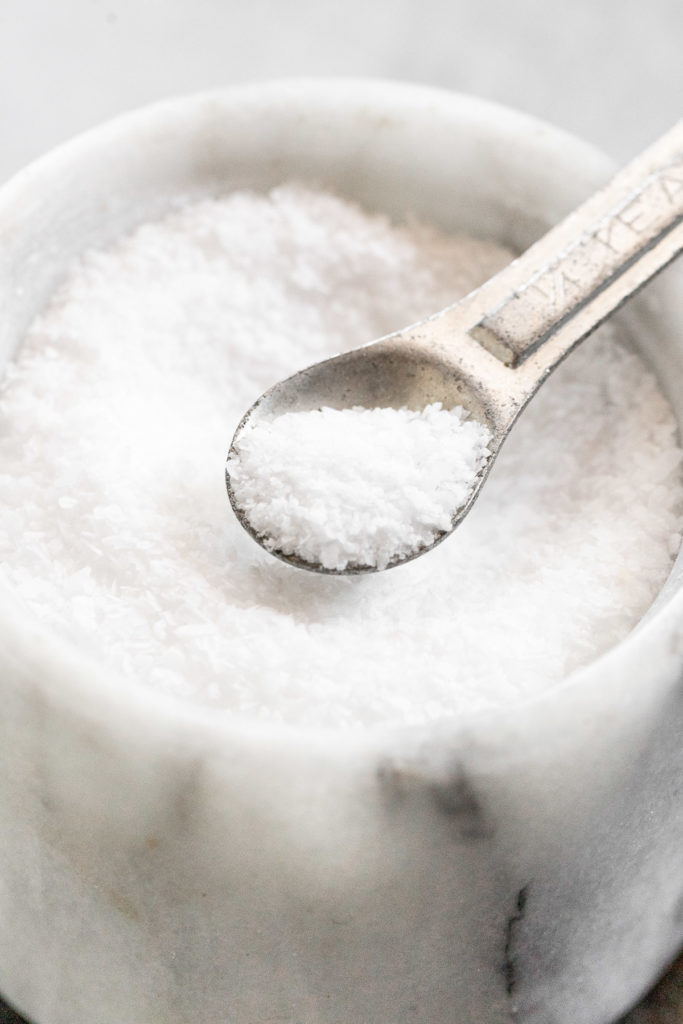
It has a lower density than a finer salt, which means it is less intense. It’s a pure salt, produced without any additives.
The two common brands of kosher salt are Diamond Crystal and Morton. Even between the brands, the salts are produced differently and have different densities. This is exactly why it’s important to consider not only the type of salt you’re using, but the brand of salt, and adjust accordingly.
Sea Salt
Sea Salt is harvested from the ocean, or yep, the sea, by evaporating the salt water. The result is large, unique salt crystals that also have trace amounts of minerals.
It’s another less processed salt (compared to table salt) so it’s purer in flavor.
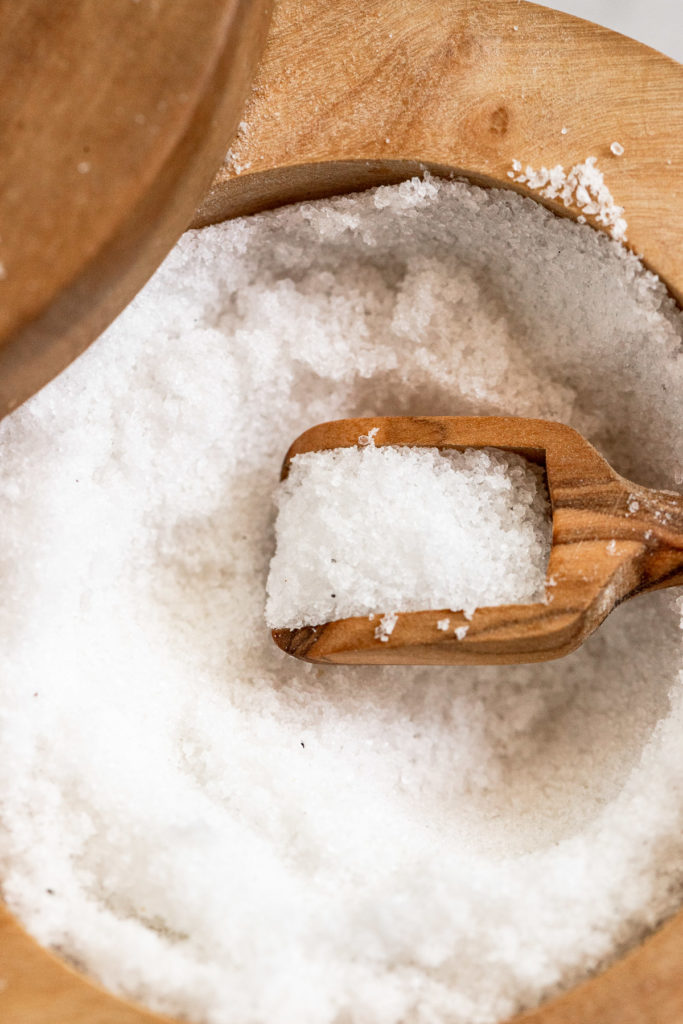
There are a variety of ways you can purchase sea salt.
- Coarse Sea Salt: used similarly to kosher salt to flavor dishes as they cook. However, if you get coarse salt that is like little pebbles you will want to use a salt grinder before adding them to dishes (see “coarse Mediterranean sea salt” in the photo at top).
- Fine Sea Salt: excellent for cooking and seasoning foods from within (layer in flavors!). It’s more similar to table salt in size, although is still a coarser grain. The two can usually be interchanged. Do proceed with caution when interchanging them though, depending on the recipe it can be far too salty if you use table salt instead of fine sea salt (shown above).
- Sea Salt Flakes: excellent for finishing dishes as a final touch in dishes where it will stand out. Think pasta, cookies, salads, and of course, rosemary bagels. It adds texture, and visual appeal, and is of course delicious. It is more expensive, which again is why you would only want to use it as a finishing touch, not to cook with (shown below).
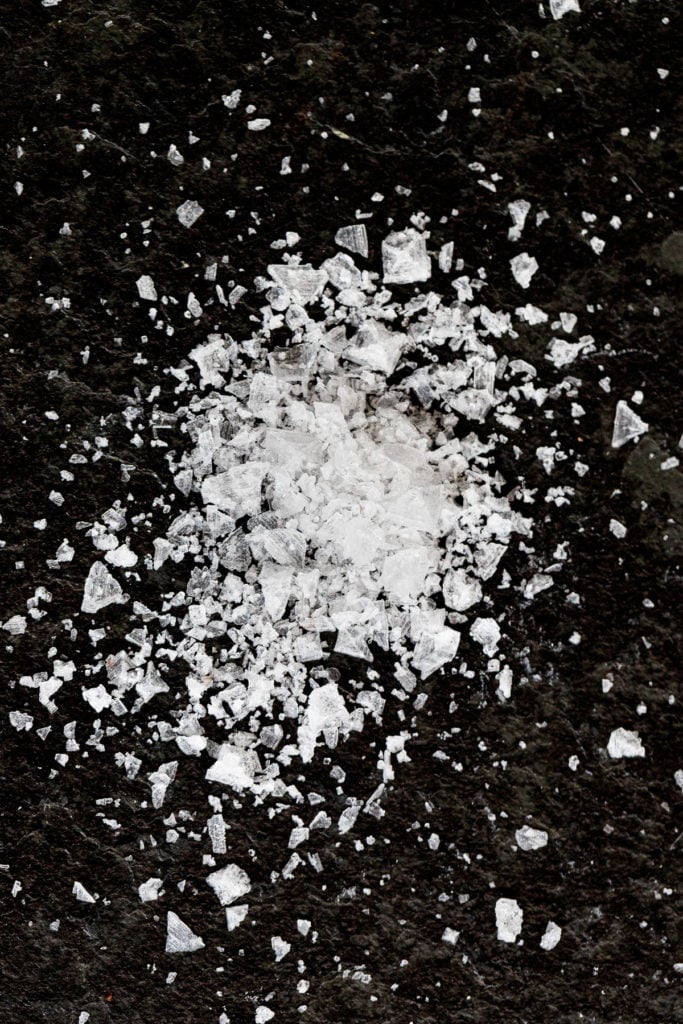
Table Salt
Table salt is the fine, granulated white salt that is most commonly found in saltshakers at restaurants or in salt packets. And if I’m being honest, this is my least favorite salt.
It is mined from underground deposits and is processed to remove other minerals, add anti-caking agents, and fortified with iodine. Iodine was added to salt in the 1920s to supplement for people who had iodine deficiency. These days, you likely get all the iodine you need from foods, so skip the iodized salt and opt for another (especially to keep your food from tasting metallic). The additives are most commonly anti-caking agents to prevent it from clumping.
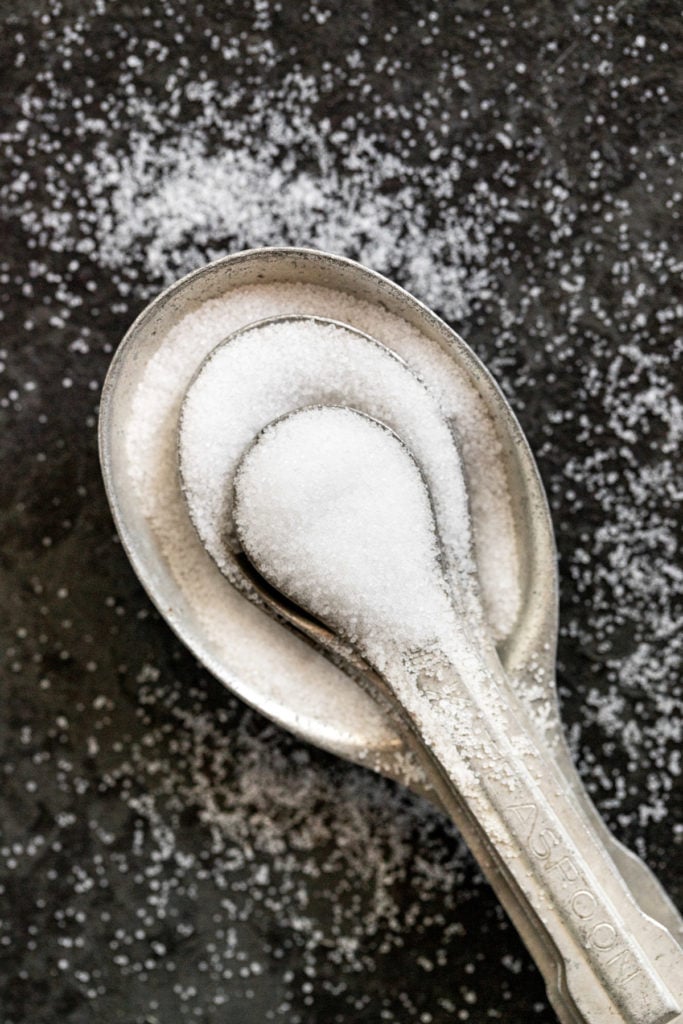
It has its place, mainly in baking or salting pasta water, but overall it’s not the salt I reach for. If you use table salt, it’s best in dishes where the salt will be diluted and where not much salt is used, or at a restaurant when you just need a little more salt. It can be easy to over salt because the crystals are all equally sized and very fine, so they are denser than other salts.
Other Kinds of Salt
That was definitely not an exhaustive list. Those three are the most common, and the ones I do recommend having in your kitchen, but walk up and down the spice aisle and you’ll likely see many more salts.
From seasoned salts to specialty salts, to different kinds of sea salts, there are so many salts to play around with.
- Himalayan Salt, or pink salt, is an excellent finishing salt because it is more expensive, although you could cook with it. It has a pink tint due to trace minerals. Recently, slabs of this salt have been used to make baking stones, lamps, and even tequila shot glasses.
- Light Grey Celtic Sea Salt: (as pictured) a variety of sea salt, it’s an unrefined mineral salt; you can find different brands of unrefined mineral salts, too.
- Flavored Salts: you can find many salt mixes and even flavored salts like truffle salt, onion and garlic salts, and more.
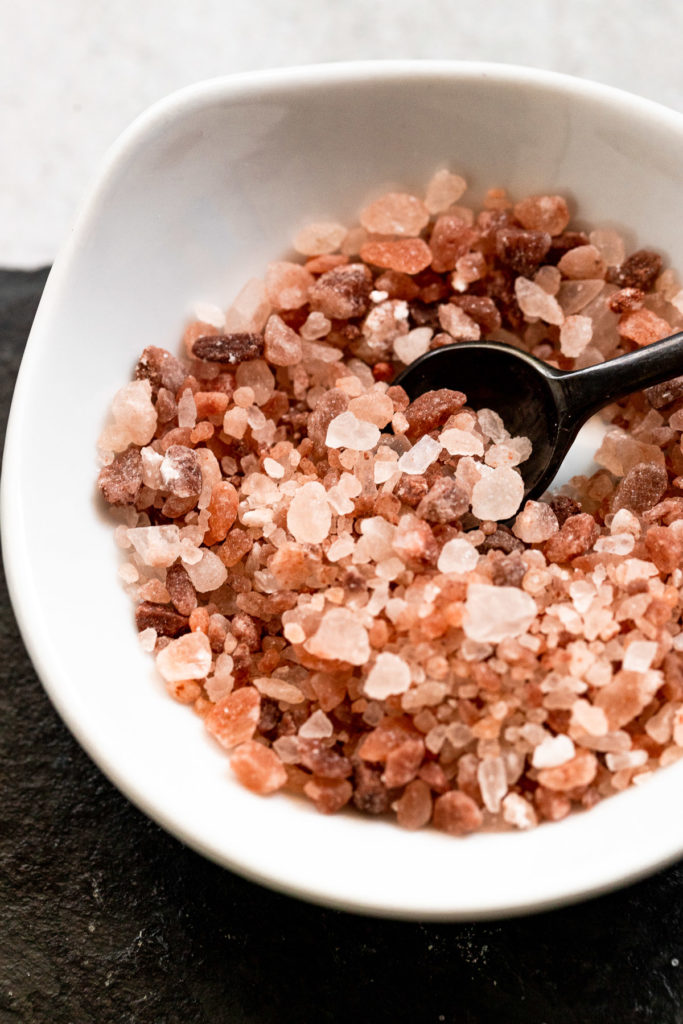
Why Density Matters
If you’ve ever thought a teaspoon of salt is a teaspoon of salt…think again.
When a specific type of salt has a higher density, that means it’s heavier; there is more salt per unit of measurement. One of the reasons why weighing ingredients, especially while baking, is the way to go!
A teaspoon of dense salt will make food saltier because there is more of salt in that little teaspoon than a less dense, or coarse-grained salt.
This means that generally, you shouldn’t swap one kind of salt for another equally, without doing some adjustments. For many recipes, you can substitute table salt for fine sea salt, and vice versa, but still be careful. Depending on the recipe, it may end up much saltier if you’re using table salt in place of fine sea salt.
How to Properly Salt Food
The one thing you can do to instantly improve your cooking is to learn to salt food properly. Salting food isn’t about making food salty, it’s about having well-salted, flavorful food.
It’s also somewhat personal. This is best learned through trial and error: salt, taste test, and adjust.
Through the process, you will learn what you like and don’t like – what’s too much, what’s not enough, and just how adding that touch more of salt really does unlock the flavor. This process will also help you know when too much salt is added because you don’t want that either.
A few key points about salting and food:
- Pasta: add salt to the pasta water to flavor the pasta as it cooks, otherwise the pasta will taste flat and flavorless in your final dish.
- Potatoes: similar to pasta, salt that cooking water so they absorb the flavor. Potatoes are also a magic little ingredient to add when you oversalt things like a soup, because they will soak it up and balance out the salt levels.
- Meat & Seafood: salting meat is SO important, and the earlier you salt, the more time it has to absorb into the meat and, you guessed it, become tender and more flavorful!
- Salads: salt a salad?! Yes! A few flakes of finishing salt help the flavors of the greens pop and reduce any bitterness.
- Breads & Baked Goods: you absolutely need salt in baking recipes to bring out the flavors and add interest, otherwise, they will be very flat.
If you’ve been around here a while, you’ll often hear me say to add salt throughout the cooking process to layer in the flavor, and it couldn’t be more true.
When making a recipe where you have various steps, like in a sauce or a soup, where you’re sauteing veggies, adding more, etc., add a pinch of salt here and there to help unlock the flavor of each ingredient. It’s worth repeating: salting is not a one-and-done kind of event, it’s a process.
When it’s time to taste, taste, and see where the salt is at, then you’ll know if you need to add more.
Layer in the flavor, don’t forget to taste test, and experiment away! Salt is key!
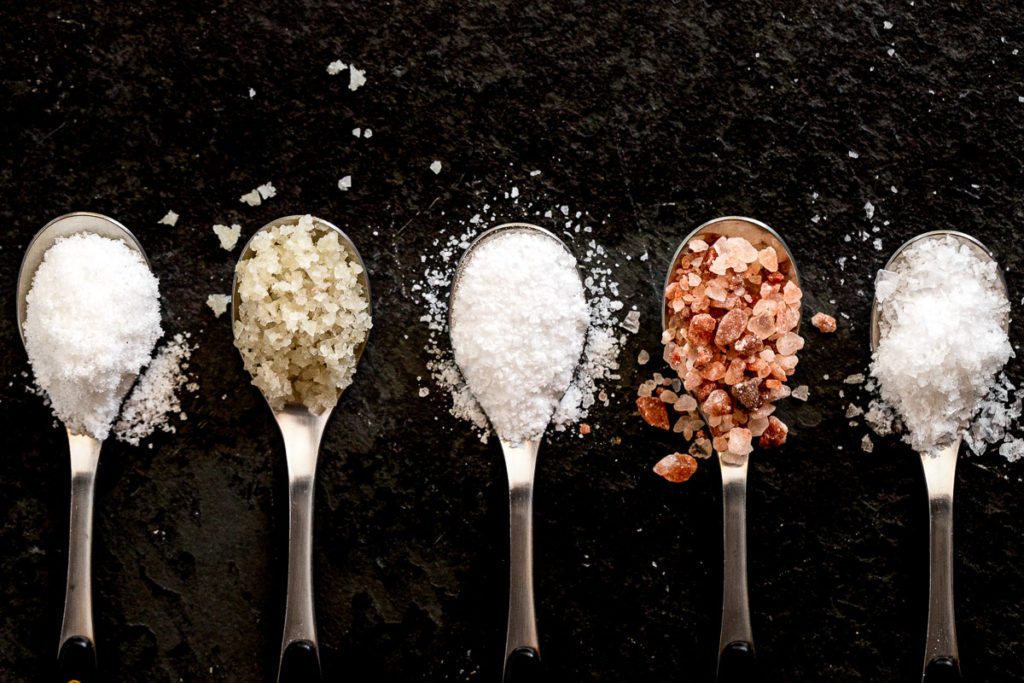
Distribute it Evenly!
I highly recommend having a salt dish that is big enough for you to fit a few fingers in to grab a pinch of salt. It’s easiest to evenly salt dishes, especially things like meat, with a pinch of salt held high above so that when you sprinkle it down, it falls evenly across the item.
Salt is antimicrobial and antibacterial, long used for preserving foods, too. So there’s not really any need to worry about those fingers doing the hard work.
Let’s Practice!
It’s worth saying again, that the best way to learn how to properly salt your food is to practice! Add some, taste, and add until the flavors pop.
- Start with a simple unsalted vegetable broth, taste it unsalted, then add salt and see how it changes.
- It’s also fun to compare the flavors between salts, for example trying a taste of Redmond Real Salt after trying regular table salt (really, try this!). You think salt is just salt…until you compare them side by side.
- Other great “practice” recipes that allow you to taste test and add salt along the way:
- Roasted Vegetables: try a few without salt, and ones with; notice how the salt brings out the flavor in the veggies.
- Whipped Ricotta: a sprinkle of fine sea salt enhances the dip SO much.
- Balsamic Bruschetta: the balsamic vinegar does have a bit of saltiness to it, but add a pinch of extra salt and taste how all of the flavors open up.
- And if you haven’t tried sea salt flakes on freshly baked chocolate chip cookies…you’ve gotta.



